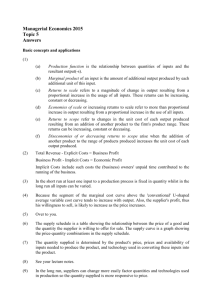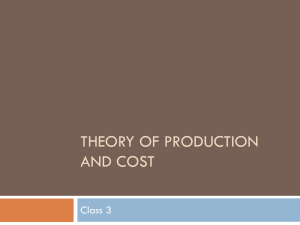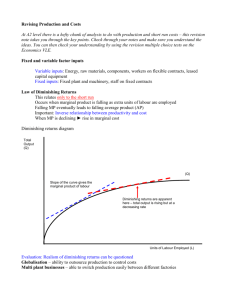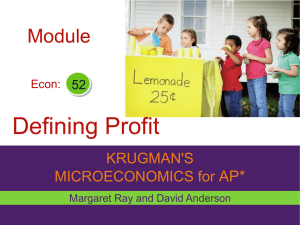CHAPTER 5
advertisement
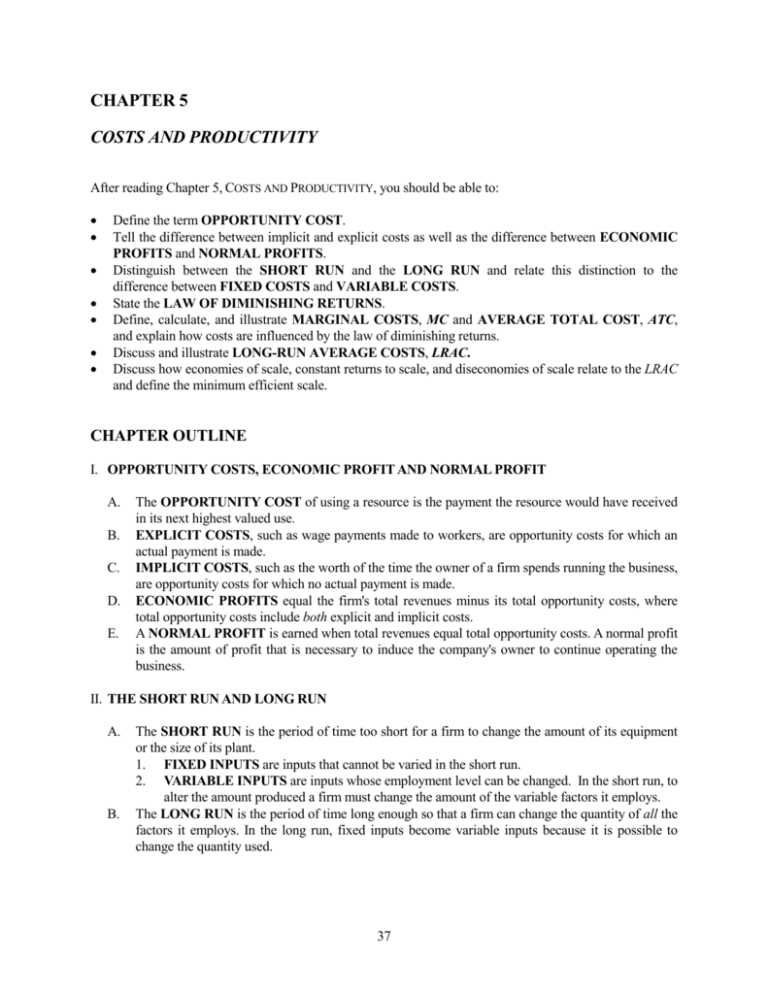
CHAPTER 5 COSTS AND PRODUCTIVITY After reading Chapter 5, COSTS AND PRODUCTIVITY, you should be able to: Define the term OPPORTUNITY COST. Tell the difference between implicit and explicit costs as well as the difference between ECONOMIC PROFITS and NORMAL PROFITS. Distinguish between the SHORT RUN and the LONG RUN and relate this distinction to the difference between FIXED COSTS and VARIABLE COSTS. State the LAW OF DIMINISHING RETURNS. Define, calculate, and illustrate MARGINAL COSTS, MC and AVERAGE TOTAL COST, ATC, and explain how costs are influenced by the law of diminishing returns. Discuss and illustrate LONG-RUN AVERAGE COSTS, LRAC. Discuss how economies of scale, constant returns to scale, and diseconomies of scale relate to the LRAC and define the minimum efficient scale. CHAPTER OUTLINE I. OPPORTUNITY COSTS, ECONOMIC PROFIT AND NORMAL PROFIT A. B. C. D. E. The OPPORTUNITY COST of using a resource is the payment the resource would have received in its next highest valued use. EXPLICIT COSTS, such as wage payments made to workers, are opportunity costs for which an actual payment is made. IMPLICIT COSTS, such as the worth of the time the owner of a firm spends running the business, are opportunity costs for which no actual payment is made. ECONOMIC PROFITS equal the firm's total revenues minus its total opportunity costs, where total opportunity costs include both explicit and implicit costs. A NORMAL PROFIT is earned when total revenues equal total opportunity costs. A normal profit is the amount of profit that is necessary to induce the company's owner to continue operating the business. II. THE SHORT RUN AND LONG RUN A. B. The SHORT RUN is the period of time too short for a firm to change the amount of its equipment or the size of its plant. 1. FIXED INPUTS are inputs that cannot be varied in the short run. 2. VARIABLE INPUTS are inputs whose employment level can be changed. In the short run, to alter the amount produced a firm must change the amount of the variable factors it employs. The LONG RUN is the period of time long enough so that a firm can change the quantity of all the factors it employs. In the long run, fixed inputs become variable inputs because it is possible to change the quantity used. 37 III. DIMINISHING RETURNS AND SHORT-RUN COSTS A. B. C. D. The LAW OF DIMINISHING RETURNS states that as extra units of a variable factor are employed, holding constant the use of all other factors, eventually the marginal product of the variable factor falls. 1. This means that the marginal product of labor—the increase in output resulting from employing one more unit of labor—eventually falls as more workers are employed. Total costs can be divided into fixed costs and variable costs. 1. FIXED COSTS (FC) are the costs of the fixed inputs. Fixed costs cannot be changed by a firm in the short run. AVERAGE FIXED COSTS (AFC) equal total fixed costs divided by total output. 2. VARIABLE COSTS (VC) are the costs of the variable factors. AVERAGE VARIABLE COSTS (AVC) equal total variable costs divided by total output. 3. TOTAL COSTS (TC) equal total fixed costs plus total variable costs, that is, TC = FC + VC. AVERAGE TOTAL COSTS (ATC) equal total costs divided by total output; that is, ATC = (TC) / (Q). Average total costs also equal the sum of average fixed costs plus average variable costs, or ATC = AFC + AVC. MARGINAL COST (MC) is the extra cost incurred when producing an additional unit of output. 1. Fixed costs do not affect the marginal cost because fixed costs do not change when output changes. 2. Variable costs influence the marginal cost because variable costs change when output changes. 3. Extra output can be produced only by hiring extra variable inputs. Since the law of diminishing returns states that the extra output produced by the additional factors eventually falls, the marginal cost of producing an extra unit of output ultimately rises. 4. The MC curve intersects the AVC and ATC curves at their minimums. The figure below illustrates the relevant cost curves. IV. LONG-RUN COSTS A. The LONG-RUN AVERAGE COST (LRAC) curve shows the minimum average cost of producing all possible levels of output. The LRAC curve is U-shaped. 1. ECONOMIES OF SCALE occur when an increase in output lowers the firm's long-run average costs. The firm's LRAC curve is falling. 2. CONSTANT RETURNS TO SCALE are when an increase in output does not change the firm's long-run average costs. The firm's LRAC curve is horizontal. 38 3. B. DISECONOMIES OF SCALE occur when an increase in output raises the firm's long-run average costs. The firm's LRAC curve is rising. MINIMUM EFFICIENT SCALE is the level of production where long-run average costs first reach their minimum. REVIEW QUESTIONS True or False If the statement is correct, write true in the space provided; if it is wrong, write false. Below the question give a short statement that supports your answer. ____ 1. Explicit costs always exceed implicit costs. ____ 2. Opportunity cost equals the loss of all the alternatives foregone when an action is undertaken. ____ 3. Only explicit costs are counted when calculating a firm's economic profits. ____ 4. A normal profit is just enough to cause a firm to commit capital to a business enterprise. ____ 5. In the short run, additional output can be produced by increasing the amount of fixed inputs employed. ____ 6. The long run equals one year. ____ 7. In the long run, all costs are variable costs. ____ 8. A firm's total costs equals its fixed costs plus its marginal cost. ____ 9. Marginal cost is the change in costs incurred when output is increased by one unit. ____ 10. The law of diminishing returns states that a firm's profits always fall as it produces more output. ____ 11. The law of diminishing returns is the reason why the marginal cost curve eventually rises. ____ 12. The long-run average cost curve shows the minimum average cost of producing each level of output when all factors are variable. ____ 13. Constant returns to scale occur when the LRAC curve is horizontal. ____ 14. The minimum efficient scale of a firm is where the marginal costs are lowest. 39 Multiple Choice Circle the letter corresponding to the correct answer. 1. Which of the following is an implicit rather than explicit cost to a firm? a. The cost of hiring an outside consultant b. The electricity used by the firm c. The time on the weekend the owner devotes to the firm's business d. The paycheck paid to the owner e. The interest paid on a bank loan 2. Total opportunity costs equals ____. a. the firm's explicit costs b. the firm's implicit costs c. the firm's marginal cost d. the firm's fixed cost e. the sum of the firm's implicit and explicit costs 3. A normal profit is earned when total revenues a. equal total accounting costs. b. equal total opportunity costs. c. are less than total accounting costs. d. are less than total opportunity costs. e. are greater than total opportunity costs. 4. Which of the following statements about the short run is false? a. Not all inputs can be altered in the short run. b. Fixed inputs cannot be changed in the short run. c. Additional output can be produced only by altering the amount of variable inputs employed. d. The firm pays no fixed costs in the short run. e. None of the above. 5. Which cost does not change in the short run as output increases? a. Marginal costs b. Variable costs c. Fixed costs d. Opportunity costs e. Explicit plus implicit costs 6. The fact that the marginal cost curve eventually slopes up as output expands reflects a. the point that fixed costs eventually increase as output expands. b. the negative slope of the average total cost curve. c. the law of diminishing returns. d. the increasing marginal product of labor. e. None of the above. 40 7. Marginal cost is a. a cost of an input that is not necessary (that is, it is marginal) to the firm's operations. b. the extra cost incurred when one more unit of output is produced. c. the change in fixed costs whenever they change. d. equal to the difference between total fixed costs and total variable costs. e. total cost divided by total output. 8. If the total average cost curve first falls, next is constant, and finally rises, the firm encounters a. first increasing, next constant, then diminishing returns to scale. b. first constant, next increasing, then diminishing returns to scale. c. first diminishing, then increasing, returns, but never a section of constant returns to scale. d. the firm always encounters diminishing returns to scale. e. It is impossible to say with the information given in the question. 9. The marginal product of labor a. is always constant. b. is part of the variable costs of the firm. c. equals marginal cost. d. is the increase in output gained by hiring one more unit of labor. e. is total costs divided by the total amount of labor. Essay Questions Write a short essay or otherwise answer each question. 1. Complete the following table: Quantity 0 1 2 3 4 5 6 Fixed Cost $5000 _____ _____ $5000 $5000 _____ $5000 Variable Cost _____ $2000 $3000 _____ $7000 $15,000 _____ Total Cost _____ $7000 _____ _____ $12,000 _____ $30,000 Average Total Cost XXX _____ $4000 $3000 _____ _____ $5000 2. Suppose Pat's Taco and Chow Mein Shoppe had revenues of $300,000 and total explicit costs of $250,000. Say that Pat worked 1000 hours in the shop without pay. If Pat could earn $10 per hour managing another fast-food stand, what is Pat's economic profit? Finally, assume that in addition to managing the stand, Pat invested $400,000 in the business. If the $400,000 could have earned a return of 15 percent in another investment, what now is Pat's economic profit? 41 3. Identify the curves in the figure. For the next two problems, use the following table. Quantity 0 1 2 3 4 5 Total Costs $30,000 $45,000 $65,000 $95,000 $130,000 $180,000 4. What is the marginal cost of producing one rather than zero units of output? Two rather than one? Three rather than two? Four rather than three? Five rather than four? 5. What is the amount of the firm's fixed costs? What is the total variable cost of producing one unit of output? Of producing four units of output? 6. Explain why a firm's long-run average cost curve is U-shaped. 7. Explain the difference between the law of diminishing returns and diseconomies of scale. ANSWERS TO REVIEW QUESTIONS True or False False 1. There is no necessary relationship between implicit and explicit costs. For some companies, explicit costs may be larger, while for others, implicit costs may be greater. False 2. The opportunity cost equals the value of only the best action sacrificed. False 3. All opportunity costs, including implicit costs, are included in order to calculate a firm's economic profit. 42 True 4. While a firm would like to earn more than a normal profit, the opportunity to earn a normal profit is the minimum profit necessary to entice a firm into investing in a business. False 5. In the short run, a firm cannot increase the amount of the fixed inputs it employs. For example, a firm cannot increase the number of assembly lines it operates. It can, however, hire an extra shift of workers to work on the assembly line; that is, it can increase its variable inputs. False 6. The long run is the amount of time necessary for a firm to be able to change the employment of all of its inputs. This is different for companies in different industries. True 7. In the long run a firm can change the employment of all factors, so all factors are variable. False 8. Total costs equal total fixed costs plus total variable costs. True 9. Marginal costs are the extra costs necessary to produce an extra unit of output. False 10. The law of diminishing returns states that as more of one input is employed while the amounts of the other factors are not changed, the marginal product of the factor being increased eventually falls. True 11. When the marginal product of a variable factor is falling, hiring an additional unit creates less output than before. But the cost of hiring the extra factor does not change, so the per-unit cost (the marginal cost) of the extra output rises. True 12. This is the definition of the long-run average cost curve. True 13. Constant returns to scale mean that the average costs of extra output (that is, an increase in the scale of the firm's operations) do not change (that is, are constant). False 14. The minimum efficient scale of a firm is where the long-run average costs are lowest. Multiple Choice 1. c. This is an opportunity cost of running the firm, since the owner could have spent that time doing something else. 2. e. Total opportunity costs measures the firm's entire costs, so it includes both implicit as well as explicit costs. 3. b. This is the definition of a normal profit. 4. d. In the short run, the firm has some fixed inputs. Payments to these inputs are fixed costs, and so the firm will have fixed costs in the short run. 5. c. Fixed costs remain constant no matter what the level of production. 43 6. c. The law of diminishing returns states that the additional output produced by hiring an extra input— say another worker—eventually declines. When this happens, the marginal cost of producing another unit of output increases because the added cost of hiring the worker remains constant, but the worker produces fewer added units of output. 7. b. Marginal cost equals the change in total costs that results from changing output a unit. 8. a. This is the standard sort of U-shaped long-run average cost curves possessed by most companies. 9. d. The key word marginal refers to changes; in this case, the marginal product of labor is the change in output resulting from hiring one additional unit of labor. Indeed, in economics, the word marginal always refers to a change! Essay Questions 1. The correct table is: Quantity 0 1 2 3 4 5 6 Fixed Cost $5000 $5000 $5000 $5000 $5000 $5000 $5000 Variable Cost $0 $2000 $3000 $4000 $7000 $15,000 $25,000 Total Cost $5000 $7000 $8000 $9000 $12,000 $20,000 $30,000 Average Total Cost XXX $7000 $4000 $3000 $3000 $4000 $5000 To see how these answers are obtained, take first the second row, where the quantity equals 1. To begin, by definition fixed cost always equals $5000, without regard for the level of production. Then average total cost equals total cost divided by the level of output, or in this case, $7000/1 = $7000. Now look at the row where the quantity equals 3. Here we first calculate the total cost. Recalling that total cost divided by output equals average total cost, that is (TC) / (q) = ATC, it makes sense that average total cost times output equals total cost, that is, (ATC) (q) = TC. Thus, in the case at hand, we have that total cost equals ($3000) (3), so that total cost equals $9000. Finally, to compute variable cost, make use of the fact that total cost equals the sum of fixed cost plus variable cost, or, in terms of a formula, TC = FC + VC. Since we know that fixed cost equals $5000 and just calculated that total cost is $9000, we see immediately that variable cost must equal $4000. The rest of the answers are computed similarly. 2. When Pat works 100 hours, there is an implicit opportunity cost of $10 x 1,000 hours, or $10,000. Thus total opportunity costs are the $250,000 of explicit costs plus the $10,000 of implicit costs, which equals $260,000. Hence, economic profits are revenue, $300,000, minus total opportunity costs, $260,000, or total economic profit of $40,000. Once we take account of the $400,000 Pat has invested in the business, the implicit opportunity cost of Pat's funds is 15 percent $400,000 = $60,000. Total economic costs become $320,000 so Pat's economic profits are an economic loss of -$20,000. 44 3. The figure appears here, with labeled curves. This is an important diagram that will recur throughout the next several chapters, so be sure you can draw it and identify the curves. 4. The marginal cost is the change in total cost divided by the change in output. Thus, the marginal cost of producing 1 rather than 0 is $15,000; 2 rather than 1 is $20,000; 3 rather than 2 is $30,000; 4 rather than 3 is $35,000; 5 rather than 4 is $50,000. 5. When a firm produces 0, it hires no variable inputs. Thus, when production is 0 all the costs are fixed costs, so the table shows that the firm's fixed costs are $30,000. Since the firm's fixed costs do not change with output, when the firm produces 1 unit its fixed costs remain $30,000. Therefore, the total variable costs equal the total costs minus the fixed costs, or $15,000. When the production level is 4, total variable costs are $100,000. 6. A firm's long-run average cost curve is typically U-shaped because the firm enjoys economies of scale from an increased ability to specialize when output is first expanded. For example, if one person runs the company, that person must produce, sell, collect past due bills, and so on. As more labor is added and output expands, workers are able to specialize, so that some sell, others keep the books, and so forth. Specialized machines also may be purchased. These gains from specialization mean that the company experiences economies of scale and output expands more rapidly than costs. Over this range of output, the LRAC is falling as output expands. Eventually, the gains from specialization become more meager while the costs of an increasing bureaucracy become larger. At this point, costs of expanding output rise more rapidly than output and the firm experiences diseconomies of scale. When this occurs, LRAC is rising as output expands. Thus, the firm's LRAC curve is U-shaped because it first encounters economies of scale and then diseconomies of scale. 7. Diminishing returns implies that the marginal product of an input will eventually fall as more of the input is employed, while the employment of all other inputs is not changed. So, only one input is varied. Diseconomies of scale take place along the long-run average cost curve whenever a change in output results in higher average costs. In this case, more than one input may be changed. The key distinction between the two concepts is in the number of inputs changed. 45
